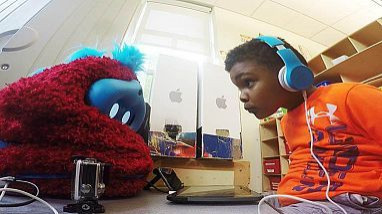NIH Will Spend $2.2 Million On Robots That Help The Elderly, Visually Impaired, And Children

They’re no WALL-E, but the National Institutes of Health (NIH) is excited about the development of three robotic devices intended to better enrich the lives of the elderly, the disabled, and the young. So much so that they’ve decided to invest $2.2 million in research funding over the next five years to help make them a reality.
“When the general public thinks about the research that NIH supports, they don’t usually imagine robots. But robots have a tremendous potential to contribute to the health and well-being of our society, whether they are helping an elderly person engage in physical activity or promoting the curiosity of a child,” said Dr. Grace Peng, program director of Rehabilitation Engineering at the NIH’s National Institute of Biomedical Imaging and Bioengineering, in a statement released Wednesday by the NIH. “These three highly innovative projects demonstrate the power of encouraging leaders in the field of robotics to focus their attention on solving issues that pertain to health.”
Robot Helpers
The projects span across the country and the age spectrum respectively.
At the University of Arkansas at Little Rock (UALR), the NIH grant, through the National Eye Institute, will fund the creation and implementation of a wearable seeing-eye robot of sorts. The glove-like robot will fit snugly on the user’s hand, where a device perched on top of the wrist will scan the environment to identify movable obstacles and indicate to their master — via “natural feedback mechanisms” — how certain objects, like a door handle, should be handled. It’s intended to help the visually impaired travel independently.The project will be spearheaded by Dr. Cang Ye, a professor in the Department of Systems Engineering at UALR.

Meanwhile, at the Massachusetts Institute of Technology (MIT), a university long known for their pioneering work in social robotics, the NIH will fund the next generation of robotic friends. The research team, led by Dr. Cynthia Breazeal, director of the Media Lab's Personal Robots group at MIT, will create an “autonomous, long-term social robotic companion for children that will promote and assess curiosity and a growth mindset through various interactions.” After its creation, Breazeal and her colleagues will take their bot on a six month trial run with real life children as they learn and play while spending time with it. It will be funded through the Eunice Kennedy Shriver National Institute of Child Health & Human Development.

And at the University of Alabama, Tuscaloosa (UAB), researcher Dr. Xiangrong Shen and his team will further their work on a four legged dual-mode robotic walker. In one application, the robot will simply function as a power-assisted walker, albeit with a 3-D computer vision-based sensing system which, when combined with its long slender legs, will allow it to easily sidestep obstacles. But it can also turn into a so-called “smart mule” that will travel alongside the user as it helps their groceries or other everyday objects. The project will be jointly funded by the National Institute of Biomedical Imaging and Bioengineering, the National Institute of Nursing Research, and the Eunice Kennedy Shriver National Institute of Child Health & Human Development.

Of course, time and patience will tell how successful these pilot projects ultimately become, but for those of us anxious for the robots of the future to get here already, the NIH’s support is sure to be a good thing.
Published by Medicaldaily.com



























